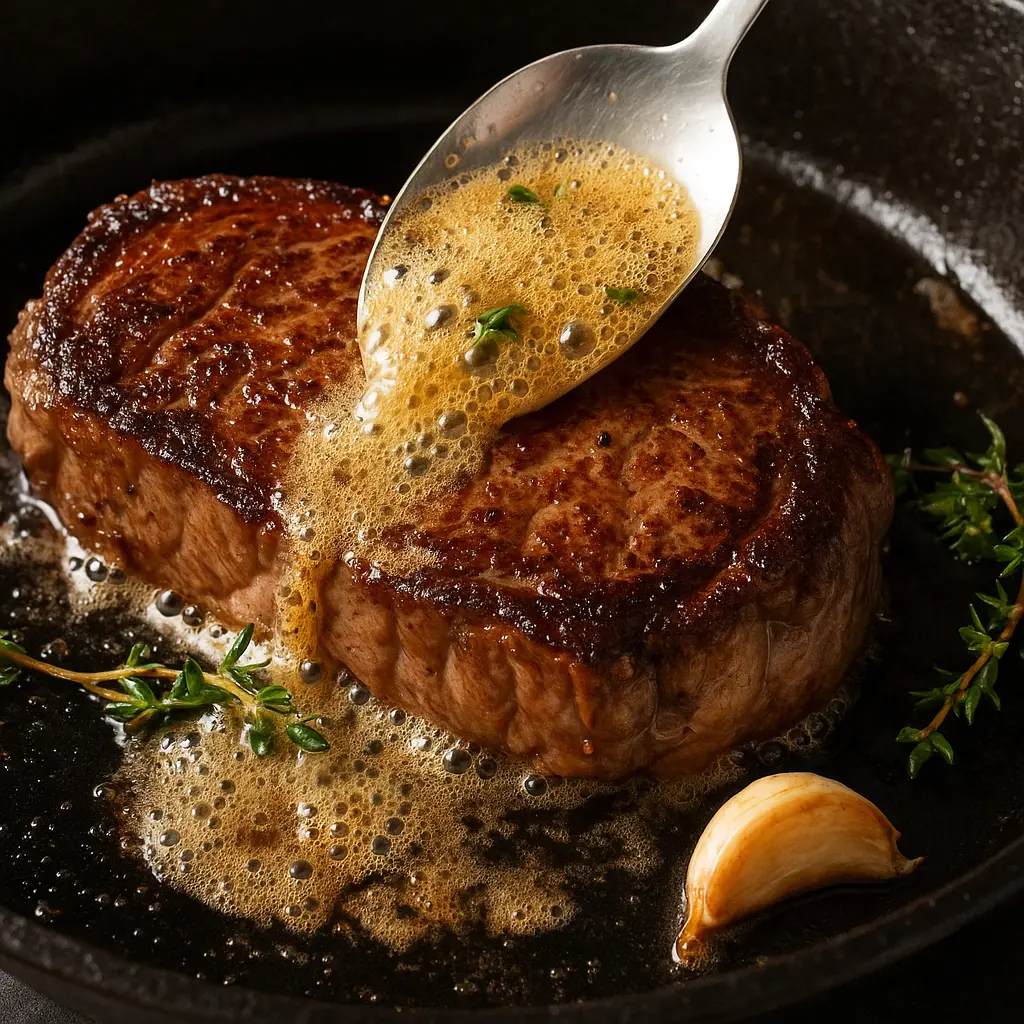This post may contain affiliate links. If you use these links to buy something we may earn a small commission. Thanks.
Few cooking techniques can elevate a steak from good to extraordinary quite like butter basting. This simple yet refined method not only infuses the meat with aromatic richness but also delivers a luxurious texture and restaurant-quality crust right in your own kitchen.
Whether you’re aiming to impress guests or treat yourself to a gourmet steak night at home, learning how to butter baste a steak is a game-changer. This guide will walk you through every step, from selecting the perfect cut to achieving the ideal sear and buttery finish.
What Is Butter Basting, and Why Is It So Good?
Butter basting is a classic French technique often used by professional chefs to finish meats, especially steak. It involves spooning hot, foamy butter over the meat repeatedly while it finishes cooking. This action does three important things:
- Enhances Flavor: Butter acts as a carrier for aromatic ingredients like garlic, herbs, or shallots, infusing the steak with complex flavors.
- Promotes Even Cooking: The hot butter gently cooks the surface of the steak, especially helpful for thick cuts.
- Improves Texture: Butter basting contributes to a beautifully bronzed crust and ultra-juicy interior.
This method works best with thick, well-marbled cuts and delivers results that rival even high-end steakhouse fare.

Choosing the Right Steak
Not every cut of steak is ideal for butter basting. To fully enjoy the benefits of this technique, start with a steak that’s thick and flavorful.
A. Best Cuts for Butter Basting
- Ribeye: Highly marbled, tender, and packed with flavor.
- New York Strip: A bit leaner than ribeye but still offers excellent texture and beefy taste.
- Filet Mignon: Lean and tender perfect for gentle butter cooking.
- T-bone or Porterhouse: Combines two great cuts in one (strip and tenderloin).
B. Ideal Thickness
Look for steaks that are at least 1 to 1.5 inches thick. Thinner cuts cook too quickly and are prone to overcooking before the butter basting can do its magic.
C. Bone-In vs. Boneless
Bone-in steaks may require slightly longer cook times, but they provide a richer flavor. Boneless options cook more evenly and are easier to handle in a pan.
D. Bring to Room Temperature
Before cooking, let your steak sit out at room temperature for 30–45 minutes. This promotes even cooking and a better sear.
Preparing the Steak
Before you even turn on the stove, you’ll want to prepare your steak for the best possible results.
A. Pat Dry
Use paper towels to thoroughly pat the steak dry. Removing surface moisture ensures a crisp sear, not a soggy steam.
B. Season Generously
- Salt: Use kosher salt or sea salt for deep flavor.
- Pepper: Fresh cracked black pepper adds subtle heat and aroma.
- Optional: A light sprinkle of garlic powder or paprika if desired.
Don’t worry if it looks like too much seasoning it’s the outer crust that packs flavor.
C. Preheat the Pan
Heat a cast iron skillet or heavy-bottomed pan over high heat until it’s nearly smoking. This is essential for a rich, dark crust.
Step-by-Step: Butter Basting a Steak
Now let’s get into the process. From searing to basting to resting, each phase plays a crucial role.
1. Sear the Steak
Ingredients You’ll Need:
- 1–2 tablespoons of a high smoke-point oil (avocado, canola, or grapeseed)
- Your seasoned steak
Steps:
- Add oil to the preheated skillet and swirl to coat the bottom.
- Gently place the steak in the pan, laying it away from you to avoid splatter.
- Don’t move it for at least 2–3 minutes. You want a deep brown crust.
- Flip the steak and sear the other side for another 2–3 minutes.
At this point, your steak should have an excellent crust but still be rare to medium-rare in the center. Time to introduce the butter.
2. Add Aromatics and Butter
What You’ll Need:
- 2–3 tablespoons unsalted butter
- 2 cloves garlic (smashed)
- 1–2 sprigs of rosemary or thyme
- Optional: thin slices of shallot
Steps:
- Reduce heat to medium or medium-low.
- Add butter to the pan along with garlic, herbs, and shallots.
- Let the butter melt and begin to foam.
The aroma at this stage will be incredible garlicky, herby, and rich.
3. Baste Continuously
Now comes the signature move: basting.
How to Do It:
- Tilt the skillet slightly so the butter pools at the bottom edge.
- Using a large spoon, scoop the hot butter and pour it repeatedly over the top of the steak.
- Continue basting for 1–2 minutes, turning the steak once more if desired.
This coats the steak with melted butter and infused flavors while gently finishing the cooking process.
4. Monitor Internal Temperature
Use a meat thermometer to check for doneness:
| Doneness | Internal Temp (Pull From Heat) | After Resting |
|---|---|---|
| Rare | 120°F | 125°F |
| Medium-Rare | 125–130°F | 130–135°F |
| Medium | 135–140°F | 140–145°F |
| Medium-Well | 145–150°F | 150–155°F |
| Well Done | 155°F+ | 160°F+ |
Pro Tip: Remove the steak from the pan once it’s about 5°F below your desired doneness, as it will continue to cook while resting.
Resting and Finishing Touches
After removing the steak from the skillet:
Let It Rest
Place the steak on a plate or cutting board and loosely tent it with foil. Let it rest for 5–10 minutes. This helps the juices redistribute, making each bite juicy rather than dry.
Optional Finishing Touch
Pour a little of the leftover butter and aromatics over the steak just before serving, or add a pat of compound butter on top.
Common Mistakes to Avoid
Here are a few common pitfalls and how to avoid them:
❌ Starting Basting Too Soon
Wait until you’ve seared both sides before adding butter, or it may burn due to high heat.
❌ Using Salted Butter
Salted butter can make your steak overly salty. Stick with unsalted butter for better control.
❌ Crowding the Pan
Only cook one steak at a time, or you risk steaming instead of searing.
❌ Skipping the Rest Period
Don’t slice too early—resting is crucial for juicy results.
❌ Overcooking
With butter basting, the process is fast. Use a thermometer and don’t walk away from the stove.
Serving Suggestions
A butter-basted steak deserves equally delicious sides and sauces. Here are some ideas:
Perfect Sides
- Garlic mashed potatoes
- Grilled asparagus or green beans
- Creamed spinach
- Roasted Brussels sprouts
- Buttery corn on the cob
- Mac and cheese
Tasty Sauces
- Chimichurri for a herbaceous contrast
- Béarnaise sauce for a French twist
- Peppercorn sauce for steakhouse vibes
- Garlic butter drizzle with parsley
Wine Pairings
- Cabernet Sauvignon (bold and tannic)
- Malbec (fruit-forward with structure)
- Syrah (peppery and full-bodied)
Bonus: Butter Basting Variations
Add a Twist with Compound Butters
Make your own flavored butter ahead of time. Try combinations like:
- Garlic-Parsley-Lemon
- Blue Cheese-Chive
- Sun-Dried Tomato-Basil
- Honey-Mustard-Dijon
Add a pat of compound butter at the end for a steakhouse finish.
Use Ghee for Deeper Flavor
Ghee (clarified butter) has a higher smoke point and offers a rich, nutty flavor without burning. It’s a great alternative if you want to try something new.
Conclusion
Butter basting a steak might seem like a fancy restaurant trick, but it’s surprisingly easy once you understand the steps. With just a handful of ingredients and the right technique, you can elevate an everyday cut of beef into something truly special.
From building the perfect crust to layering in flavor with herbs and garlic, this method delivers a show-stopping steak every time.
So, next time you’re craving a steak dinner, ditch the grill and grab a pan your taste buds will thank you.
